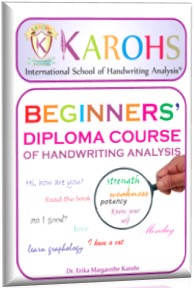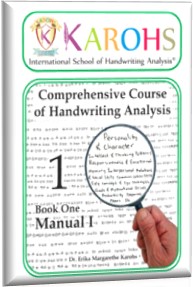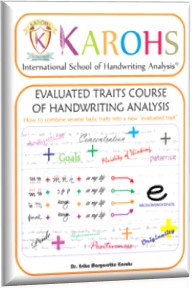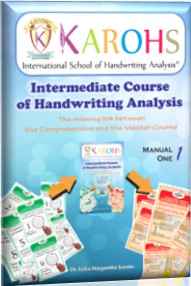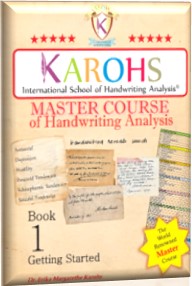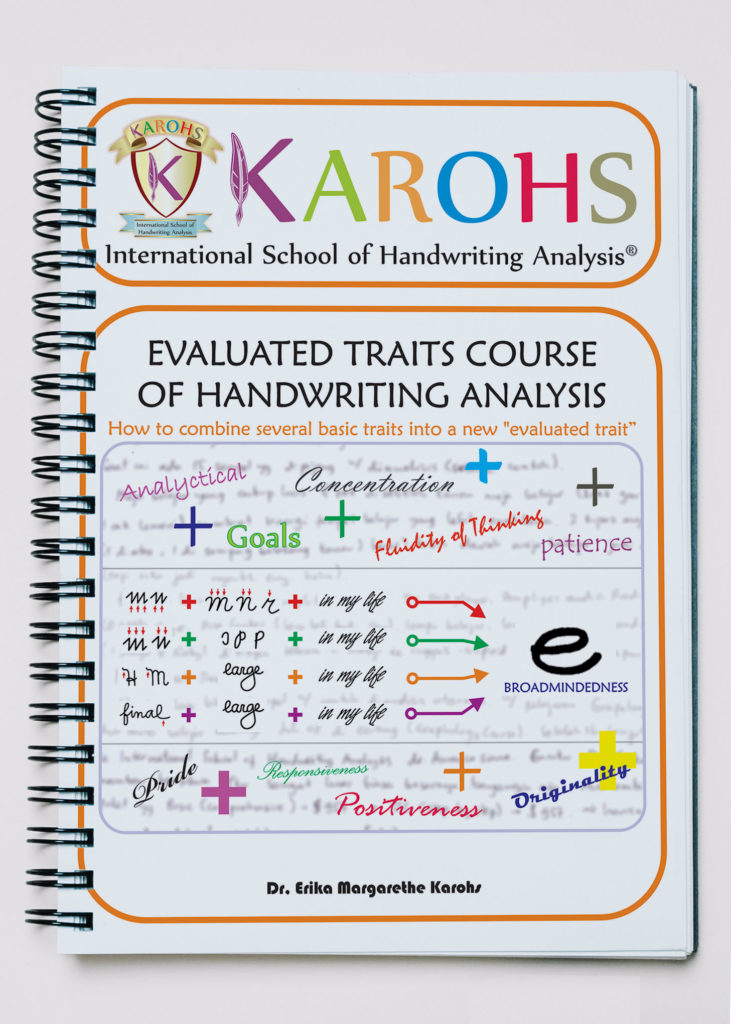Free Article about Handwriting Analysis
From “Sunday Lessons III”
- Sunday Lesson #6: Accident Proneness
From 1951 to 1955, Dr. Heinrich Pfanne, renowned German graphologist, lectured in various parts of the former East Germany. I was very fortunate to be able to hear him during his lectures in Rudolstadt. Thuringia.
In 1955, in response to many requests, Pfanne published those lectures in a small volume Wesen und Wert der Graphologie (Essence and Merit of Graphology). In one of the chapters he touches upon the subject of accident proneness as seen in handwriting.
According to Pfanne, insurance companies have long ago discovered that one particular group of people seems to suffer a large percentage of all accidents, whereas other individuals remain relatively accident free. Unfortunately, industry often keeps such persons in hazardous work situations and will relocate them only after a series of additional mishaps.
Merten states that “some people have a high susceptibility to accidents. They are restless and distracted, inclined to trust luck. They take their chances to prove that they can handle any emergency.” He adds that these individuals tend to develop an “accident habit” and “often show a history of minor collisions before a major injury is incurred.”
Many losses, both financial and health wise, could be prevented if accident proneness were recognized before hiring vulnerable people for dangerous jobs.
A few months ago, one of my international client companies asked me to prepare special “Profiles” for around 100 of their blue color workers covering 6 traits that are of special significance to them. One of those traits was accident proneness. The Profiles were done from the handwriting of workers who are already employed. If there is a high percentage of agreement between the Profiles and the company’s actual experience with these employees, these Profiles will be done for several thoursand workers in their factories.
The indicators I used for accident proneness were:
- nervousness
- poor concentration
Nervousness
According to Merten, these writers are “nervous and agitated without reason. They are restless and it irritates them to be inactive. Often, their movements are random, without purpose and direction. They may be finger-drumming and foot-tapping. They pace, just for the sake of moving. Their mind is not easily directed toward one activity for a longer period of time.”
Handwriting indicators for nervousness:
- corrections (especially of upper and lower zone loops)
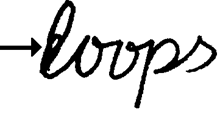
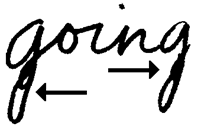
- going over downstrokes a second time (will appear darker than rest of writing)

- breaks in downstrokes
- breaks in upstrokes (not so critical)

- soldered connections (individual strokes look as is they are soldered or “sautered” together)

- fragmented letters

- ataxia and/or tremor
- extra downstrokes in m’s and n’s
- extremely variable middle zone height
- extremely variable slant
- extremely irregular spacing
- displaced pressure in upstrokes (pressure is in upstrokes rather than in downstrokes)

- sudden erratic pressure
- very light pressure or thread are possible
- A minimum of six indicators suffice as evidence.
Poor concentration
These writers have a short attention span. They bore easily and need an energy release, such as constant moving about or talking. Pophal states that “they are unable to relax and wear themselves out physically.”
Mental distraction, forgetfulness, inattention to details and an inclination toward making mistakes are results of poor concentration.
Most often, such people work inattentively and carelessly. They seem unaware of the need for caution. They rarely take the time to examine a situation thoroughly before becoming involved. Since they respond without forethought to unfamiliar situations, they are liable to wrong responses. Mendel declares that “because of their reckless disregard of necessary precautions, they pose a safety risk in hazardous jobs. Very probably,” he concludes, “they would also be unpunctual, disorderly and indolent.”
Handwriting indicators for poor concentration:
- Irregularity of slant, spacing, height and width
- thready writing

- very light pressure
- loops extremely broad
- ostentatious embellishments
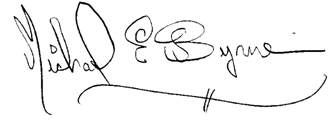
- very large writing
- upper zone height very irregular
- missing i-dots
- missing t-bars
- missing ties on t’s and f’s
- very fluctuating baseline
QUIZ
Every one can participate!
Send in an answer!
Submit the best answer
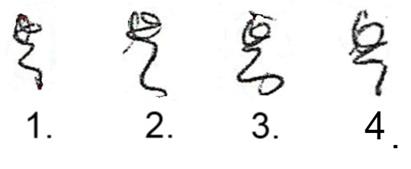
One of my students wrote:
“I am analyzing a client’s handwriting but I really don’t know how to interpret these four letters. They are small cursive “g’s.” Can you help me?
I felt that this is a good time for everyone to test their own graphology knowledge.
If you found these letters in a handwriting, what would you tell your client?
Please e-mail your answers support@karohs.com .
Instructions for Quiz submission:
- Include your answer INSIDE the e-mail, not as an attachment.
- Write in the e-mal subject line “Sunday Lesson Quiz.”
- Only serious answers will be accepted (don’t try to by cute and write “the letter looks like a pigtail,” or something like that).
- Number and describe each letter individually.
- Describe in detail in which part of the letter you recognize a certain trait and describe the indicator and the the trait. Be very specific.
Hint!
There are at least 12 traits in those four letters.
Have fun and Good Luck!
Erika M. Karohs, Ph. D., Ed. D.
- Heinrich Pfanne, Wesen und Wert der Graphologie (Rudolstadt: Greifenverlag, 1955).
- Winfried Merten, An Introduction to Handwriting Analysis (Erfurt: Domverlag, 1948).
- Rudolf Pophal, Kinetische Graphologie (Stuttgart: Gustav Fischer Verlag, 1966).
- Alfred O. Mendel, Personality in Handwriting (New York: Stephen Daye Press, 1975).
I hope you enjoy “Sunday Lessons Series III”. If you have any questions or would like to recommend topics, please feel free to email me at info@karohs.com
See detail courses programs (click the image below):
Evaluated Course (Combination Traits) of Handwriting Analysis
The Evaluated Traits Handwriting Analysis Course is a one-of-a-kind advanced trait stroke course that at this time, in this format, you cannot find anywhere else.
Most handwriting analysts are familiar with basic traits. One letter or stroke symbolizes a certain characteristic. Basic traits go back a long time.
After Michon’s death, Jules Crépieux-Jamin became the most important French graphologist. To him we owe the so-called “Theory of Resultants” which distinguishes between primary and secondary traits. In his book, “L’ECRITURE ET LE CARACTERE” (Paris 1889), he theorized that only the primary traits show. The secondary or “resulting” characteristics have to be evaluated through combinations of primary or basic traits.
Crépieux-Jamin called these evaluated traits resultants. Some of the resultants listed in his book L’Écriture Et Le Caracterè are:
- Weak will + imagination = fear
- Evasiveness + dishonesty = tendency to steal
- Sensitiveness + weak will power + self-underestimation = timidity
- Generosity + responsiveness + enthusiasm = empathy
Crépieux-Jamin examined hundreds of handwriting specimens to illustrate how a clustering of basic traits creates a certain evaluated trait.
Crépieux-Jamin believed the procedure of establishing evaluated traits or resultants to be one of the most intriguing aspects of graphology.
Crépieux-Jamin claimed that every characteristic in the personality can be found in the writing, either as a basic or as an evaluated trait.
Today, the concept of evaluated traits has become an important part of most contemporary schools of handwriting analysis.
If you would like to learn to work with evaluated traits, or if you would like to refresh your knowledge about evaluated traits, the Evaluated Traits Course is certainly for you.
HOME
Click here to back to KAROHS Home Page
COURSE
Click here to see our Course Programs
BOOKS
Click here to see our Books Store
Copyright © 2018 the KAROHS International School of Handwriting Analysis®. All rights reserved.
No image or portion of this website may be copied or reproduced without written permission.


